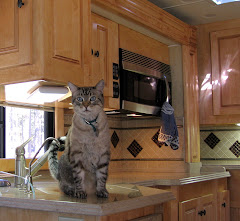 |
| From Shelbourne Museum Overview |
If there is one thing I want to see while in Vermont, this museum is it. Fortunately it's not far from our home base in South Hero, Grand Isle, Lake Champlain. This round barn, originally from East Passumpsic VT, 1901, houses the McClure Visitor Center, museum entrance and most of the Full Throttle: Vintage Motorcycles, Custom Choppers and Racing Machines; all on special exhibit this season.
 |
| From Shelbourne Museum Overview |
This is but one example of a custom chopper. More will follow. Admission covers two continuous days, and we needed every minute to cover the 39 buildings containing exhibits on approximately 45 acres.
 |
| From Shelbourne Museum Overview |
One of the most visited exhibits is the steam ship Ticonderoga, originally in Shelburne Harbor in 1906. It is a National Historic Landmark Lake Champlain Steamboat and the story of moving it to this location is a story all by itself.
 |
| From Shelbourne Museum Overview |
This lighthouse, originally from Colchester Reef, Lake Champlain, 1871 is currently filled with the folk art of Warren Kimble. It is an awesome exhibit.
 |
| From Shelbourne Museum Overview |
Here is a sample of what is inside. An entire post will be shown for this and many other exhibits; all too awesome to cover in just one post.
 |
| From Shelbourne Museum Overview |
An example of the many gardens, the Bostwick Memorial Garden is but one example. The sculpture, Turtle Baby, is by artist Edith Parsons, (1878-1956).
 |
| From Shelbourne Museum Overview |
This lamp, a Louis Comfort Tiffany, is part of the Nature by Design display of jewelry, lamps, stained glass and furniture currently in the Webb Gallery. You'll see more soon!
 |
| From Shelbourne Museum Overview |
This covered bridge came from Cambridge, Vermont, 1845. This museum is quintessential Vermont. You literally get the feeling for the entire state by visiting this museum.
 |
| From Shelbourne Museum Overview |
This moose is part of the bronzes of the American West exhibit, contained downstairs in the Electra Havemeyer Webb Memorial Building.
 |
| From Shelbourne Museum Overview |
This original Heidelberg press is contained in the Print Shop, built in 1955, containing presses from the 1820s to the 1950s. To my knowledge, they are in working condition, and provide wonderful job security for someone!
 |
| From Shelbourne Museum Overview |
This blacksmith shop came from Shelburne in 1800. Docents do a great job of demonstrating all the crafts shown, and this living museum is truly an American treasure.
 |
| From Shelbourne Museum Overview |
The Shaker Shed (Canterbury, New Hampshire, 1840) contains woodworking tools, ironwork, housewares and more. The entire museum contains over 150,000 items; impossible to cover in two days.
 |
| From Shelbourne Museum Overview |
Now we come to the Horseshoe Barn, built in 1949, to house carriages, wagons and sleighs.
 |
| From Shelbourne Museum Overview |
Look at the unique vertical and ornate machine on the right side of the fireplace. I believe the museum contained 4 or 5 of these. Think of them as the original rotisserie. Although they were made in Europe, settlers brought them to tend their meats while roasting. I've never seen these before and found them fascinating. I should add that while photography is allowed, must flash photography is NOT allowed, making for some very poor picture quality. Therefore, I have not included many of the interesting interiors of the houses on display. The website, listing at the end of this post, will show more.
 |
| From Shelbourne Museum Overview |
This horseshoe shaped building is the Circus Building, built in 1965 to house a miniature circus parade, three-ring circus, circus posters, carousel figures, and special exhibition on collections, care & conservation.
 |
| From Shelbourne Museum Overview |
An example of a carousel figure from the Circus Building.
 |
| From Shelbourne Museum Overview |
The Meeting House came from Charlotte, Vermont, 1840.
 |
| From Shelbourne Museum Overview |
One of only a handful of decent pictures I took from the Variety Unit containing decorative arts, glassware, pewter, ceramics, scrimshaw, dolls and more. Everything is under glass and the lights bounce off everything.
 |
| From Shelbourne Museum Overview |
The Vermont House Gallery (Shelburne, VT, 1790) houses selections of American and European Art from the collection of Theodore H. Church.
 |
| From Shelbourne Museum Overview |
An example of the beautiful dolls upstairs in the Variety Unit.
 |
| From Shelbourne Museum Overview |
An example of American Art from the Church collection in the Vermont House Gallery.
 |
| From Shelbourne Museum Overview |
A one room 19th century rural school house moved to the museum in 1947.
 |
| From Shelbourne Museum Overview |
The Hat and Fragrance Textile Gallery features the quilts of Florence Peto, Patty Yoder Rugs of the Black House Farm, and other exhibits on loan from 1914 - 1945.
The posts that follow this will be a snapshot of many of the exhibits, presented mostly without commentary. Electra Havemeyer Webb (1888 - 1960), the daughter of Sugar Baron H.O. and Louisine Havemeyer travelled the world with her parents, ardent collectors of European and Asia art, grew up with an eye for the extraordinary. She collected anything and everything she found beauty in, and the result is this wonderful museum of American Art. I hope you enjoy this as much as Bob & I.
For further information: The Shelburne Museum










No comments:
Post a Comment